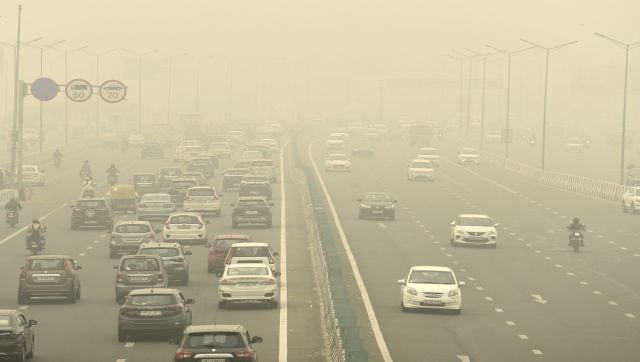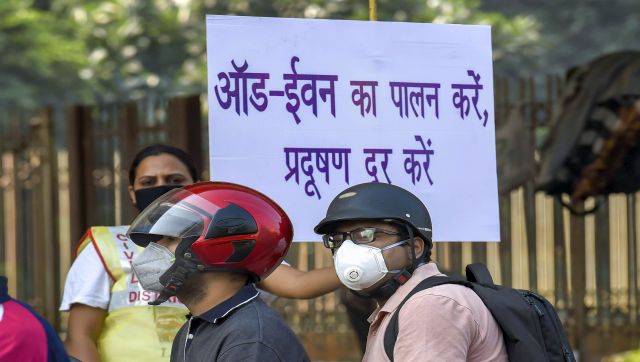Winter is here and Delhi’s apocalyptic air quality has left people gasping for their breath. On Tuesday morning (7 November), the air quality remained in the severe category – sixth day on the trot. Delhi’s Anand Vihar recorded an AQI (air quality index) of 432, R K Puram at 437, and Punjabi Bagh at 439. This comes after Anand Vihar last week saw an unbelievable AQI of 999 with a thick toxic smog enveloping the area. Given the alarming levels of pollution – doctors have urged people to mask up – the Delhi government announced the implementation of the odd-even scheme from 13 to 20 November and also announced the closure of schools this week. “We have taken a key decision to reintroduce the odd-even scheme from November 13. It will remain in effect for seven days,” Delhi environment minister Gopal Rai said while addressing the media on Monday. The situation in Delhi has also prompted the authorities to stop the entry of diesel trucks and ban construction activities in the city under Stage-4 of the Graded Response Action Plan ( GRAP ). As these measures come into place, we take a closer look at what is the odd-even rule and how effective is it in the fight against air pollution.
What is the odd-even rule? As the name suggests, the odd-even rule allows cars with only odd or only even number plates to ply on a particular day. In simple terms, if your car carries an ‘odd-number’ registration plate, you will only be allowed to drive it on an odd day and vice versa for even days. This time around, cars whose number plates end with odd numbers – 1, 3, 5, 7 and 9 – will be allowed to ply on odd-numbered dates – 13, 15, 17 and 19 November. Similarly, vehicles whose number plates end with even numbers – 0, 2, 4, 6 and 8 – will be allowed to ply on even-numbered dates – 14, 16, 18 and 20 November. The rule is applied only for private vehicles and those who fail to comply with the odd-even rule or violate the terms are charged a fine by the traffic authorities. In the previous phases of the scheme, two-wheelers, women-only vehicles, CNG, hybrid and electric vehicles, emergency vehicles and VIPs were exempted from it. Apart from VIPs, politicians, Supreme Court judges and defence vehicles, single women drivers and women drivers with children below the age of 12 were also exempted. [caption id=“attachment_13357302” align=“alignnone” width=“640”] Traffic moves on a road enveloped by fog and smog in New Delhi. Authorities have shut schools and banned polluting vehicles and construction activity to control the worst haze and smog this season, causing respiratory infections among people and enveloping monuments and high-rise buildings in and around New Delhi. AP[/caption] The scheme was first implemented in Delhi in 2016 by the Arvind Kejriwal-led Aam Aadmi Party government to curb the rising levels of air pollution. However, this scheme has been used in the past across the world; it was first instituted in the United States in 1979. Later, the US implemented the odd-even scheme following Hurricane Sandy in 2012. Gasoline prices had skyrocketed after it became scarce and in order to bring down the prices, the American authorities had adopted the scheme. Countries such as China, France, Italy and Mexico have also applied the odd-even scheme in order to battle air pollution. Does the scheme fight air pollution? However, the question that many are asking is – does the car-rationing scheme work in the fight against pollution? Experts note that reducing the number of cars would reduce the pollution levels, but it is not a silver bullet in the fight against poor air quality. Multiple studies have shown that cars and bikes spew out toxic particles, becoming a major contributor to air pollution. Some research pegs vehicular emissions to be 18 per cent, while others have pegged it at 39 per cent. This means that the odd-even scheme would be a perfect solution to air pollution. But the research isn’t definite. A study by the Delhi Technological University in 2016, when the scheme had been implemented for a two-week period, the concentration of PM 2.5 and PM 1 saw a drop. Other studies also showed a reduction in PM 2.5 of 5.73 per cent and 4.70 per cent in PM 1 levels. [caption id=“attachment_13357332” align=“alignnone” width=“640”]
 Car and vehicles are believed to be a major contributor to air pollution. However, research isn’t definitive on whether the odd-even car scheme will help in tackling bad air quality in Delhi. PTI[/caption] However, another research published in the latest issue of the journal Current Science revealed that the scheme was ineffective in reducing traffic emissions. The researchers identified two reasons for the scheme’s failure – people shifting their travel schedule to beat the 8 am-8 pm restrictions and a sharp rise in the number of buses, auto-rickshaws, taxis and two-wheelers that were exempted from the road rationing rule. The study’s findings showed that though the car-rationing scheme helped in reducing traffic congestion, it triggered a fleet emission response where increased exempt-vehicle activity negated the curtailed effects of emissions from non-exempt vehicles.
**Also read: Living in ‘gas chambers’: What is making Delhi’s air so toxic?** Gufran Beig, the founder project director, SAFAR, told Indian Express: “It would have to apply to all vehicles for it to make a significant difference. There are exemptions to the scheme. Applied to cars, congestion might reduce with the odd-even policy, and it may result in a decline in re-suspended dust. Overall contribution of the transport sector is about 40 per cent, and of this, emissions from four wheeler cars are around eight per cent. If 50 per cent of vehicles are on the road, you can cut this to around four per cent.” Another study was optimistic in its findings. The Energy Policy Institute at the University of Chicago (EPIC) for the NCAER 2017 India Policy Forum estimated a big decrease in air pollution through the odd-even scheme. By comparing PM2.5 data from Delhi’s monitors with data from monitors in neighbouring cities (such as Gurgaon and Noida) where odd-even did not apply, the study found that the January 2016 odd-even pilot in the winter decreased air pollution during the day by 14 per cent to 16 per cent (but there was no impact during the April 2016 pilot). Some medical experts opine that even though there is no clarity on how effective the odd-even scheme is on reducing particulate matter in the air, it does help in reducing levels of gaseous pollution such as nitrogen dioxide. This is particularly important because a recent study from AIIMS found that there was a higher increase in hospital visits when there is an increase in nitrogen dioxide; short-term exposure led to a 53 per cent increase in patients visiting hospitals. But amid these differing views, one thing is certain: Delhi needs a long-term holistic approach to tackling air pollution. [caption id=“attachment_13357342” align=“alignnone” width=“640”]
Car and vehicles are believed to be a major contributor to air pollution. However, research isn’t definitive on whether the odd-even car scheme will help in tackling bad air quality in Delhi. PTI[/caption] However, another research published in the latest issue of the journal Current Science revealed that the scheme was ineffective in reducing traffic emissions. The researchers identified two reasons for the scheme’s failure – people shifting their travel schedule to beat the 8 am-8 pm restrictions and a sharp rise in the number of buses, auto-rickshaws, taxis and two-wheelers that were exempted from the road rationing rule. The study’s findings showed that though the car-rationing scheme helped in reducing traffic congestion, it triggered a fleet emission response where increased exempt-vehicle activity negated the curtailed effects of emissions from non-exempt vehicles.
**Also read: Living in ‘gas chambers’: What is making Delhi’s air so toxic?** Gufran Beig, the founder project director, SAFAR, told Indian Express: “It would have to apply to all vehicles for it to make a significant difference. There are exemptions to the scheme. Applied to cars, congestion might reduce with the odd-even policy, and it may result in a decline in re-suspended dust. Overall contribution of the transport sector is about 40 per cent, and of this, emissions from four wheeler cars are around eight per cent. If 50 per cent of vehicles are on the road, you can cut this to around four per cent.” Another study was optimistic in its findings. The Energy Policy Institute at the University of Chicago (EPIC) for the NCAER 2017 India Policy Forum estimated a big decrease in air pollution through the odd-even scheme. By comparing PM2.5 data from Delhi’s monitors with data from monitors in neighbouring cities (such as Gurgaon and Noida) where odd-even did not apply, the study found that the January 2016 odd-even pilot in the winter decreased air pollution during the day by 14 per cent to 16 per cent (but there was no impact during the April 2016 pilot). Some medical experts opine that even though there is no clarity on how effective the odd-even scheme is on reducing particulate matter in the air, it does help in reducing levels of gaseous pollution such as nitrogen dioxide. This is particularly important because a recent study from AIIMS found that there was a higher increase in hospital visits when there is an increase in nitrogen dioxide; short-term exposure led to a 53 per cent increase in patients visiting hospitals. But amid these differing views, one thing is certain: Delhi needs a long-term holistic approach to tackling air pollution. [caption id=“attachment_13357342” align=“alignnone” width=“640”] People walk on ‘Kartavya Path’ amidst the morning smog. Delhi has continuously seen poor air quality for the past few days. Reuters[/caption] How bad is Delhi’s air right now? Air quality in the National Capital has been deteriorating – it’s been in the severe category for days now. According to this year’s air quality life index, compiled by the University of Chicago’s energy policy institute, the people of Delhi could have their lives shortened by 11.9 years due to the poor air they breathe.
**Also read: In graphics | How Delhi smog can be deadly** Doctors in Delhi said they have already begun to see the damaging impacts of pollution on the city’s residents. “The number of patients with breathing problems has increased, with more people having coughs, colds, watery and irritated eyes, and breathing problems. People of all ages are affected by this. It is time for us to wear masks and go out only when needed,” Nikhil Modi, a doctor at Apollo hospital in Delhi told The Guardian. And in order to tackle this situation, a number of measures, including the odd-even scheme have been implemented. However, only time will tell how long before the Capital can breathe easier again. With inputs from agencies


)

)
)
)
)
)
)
)
)



